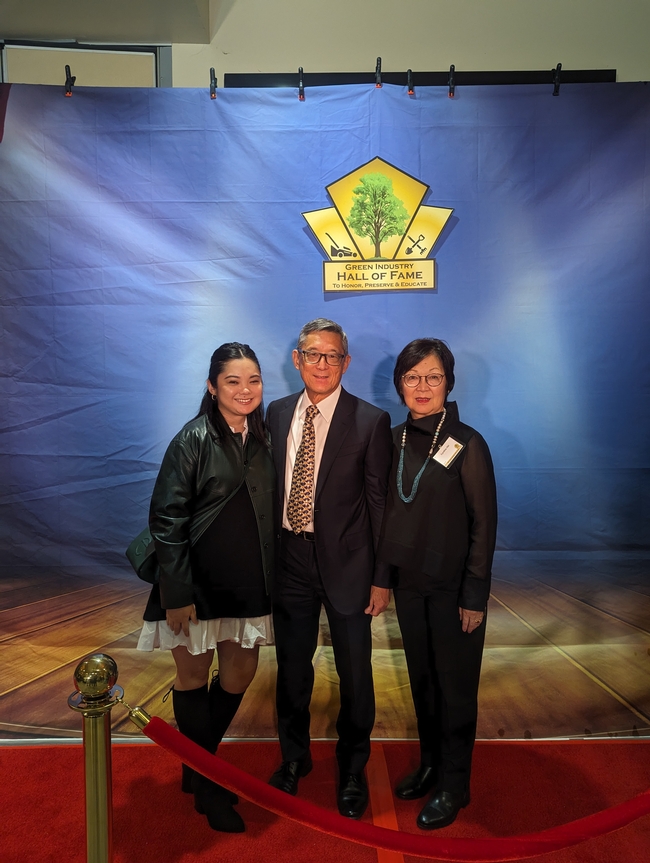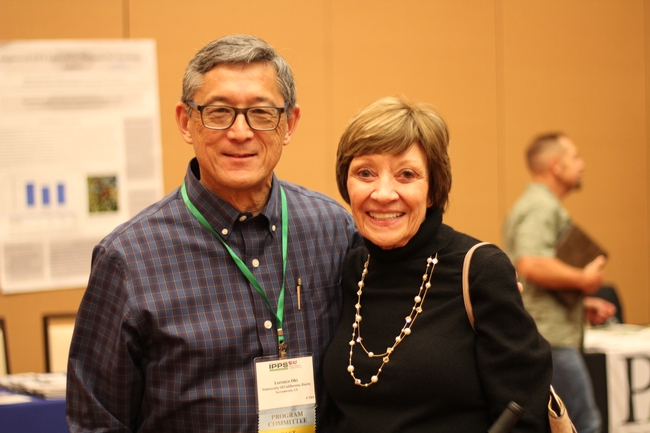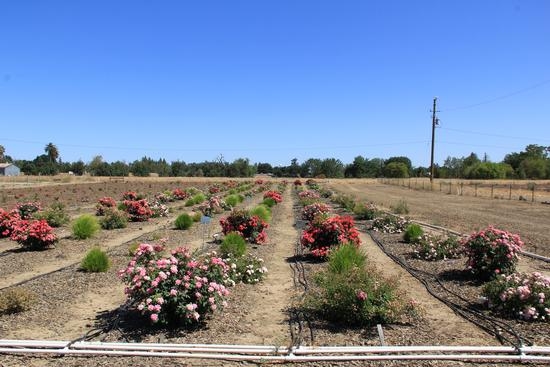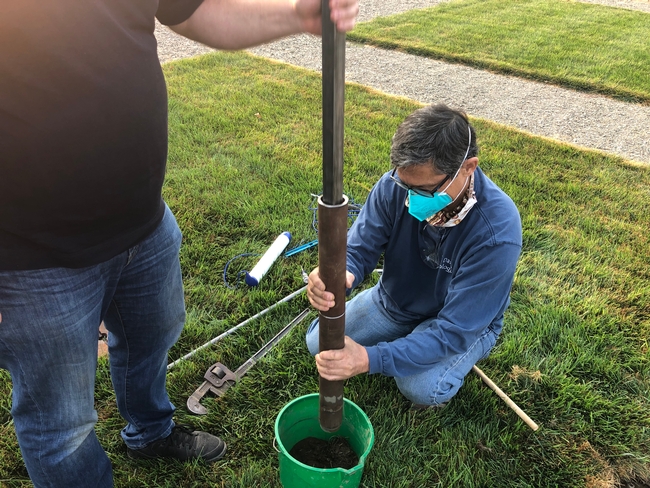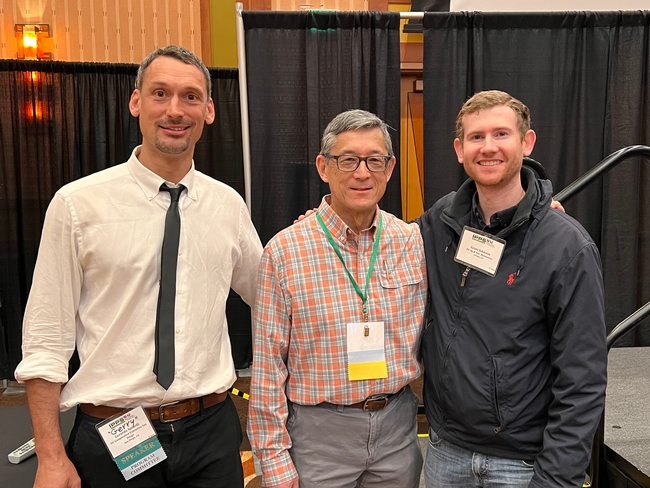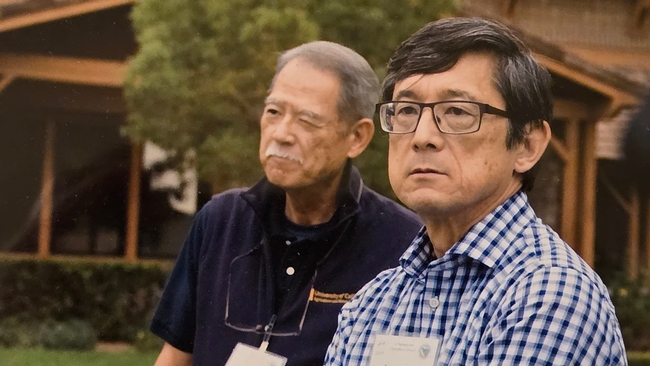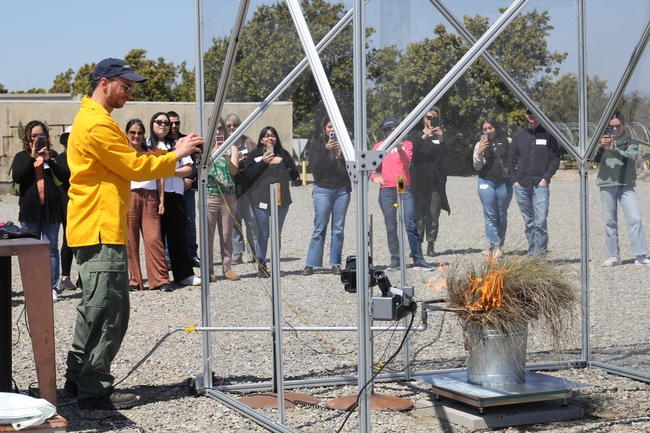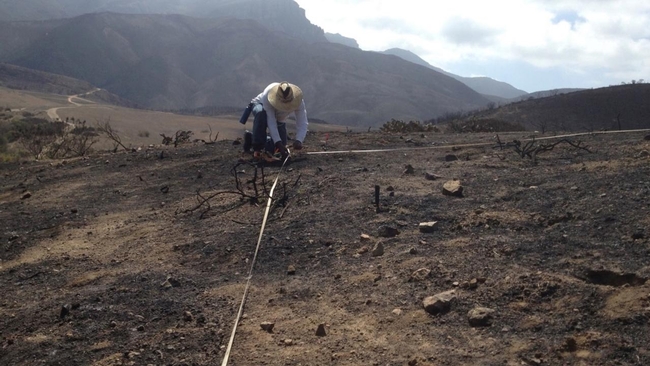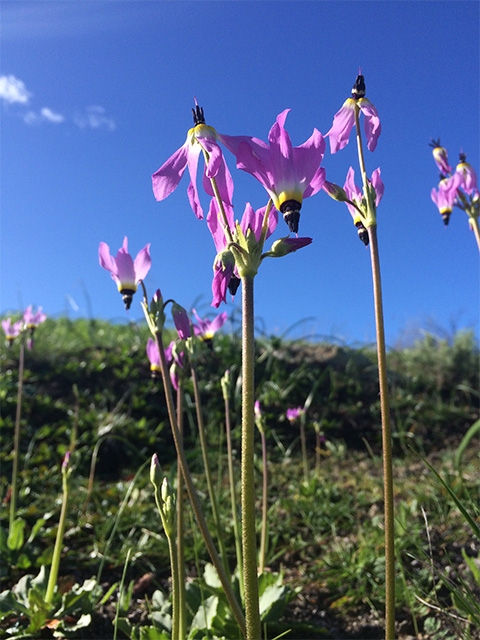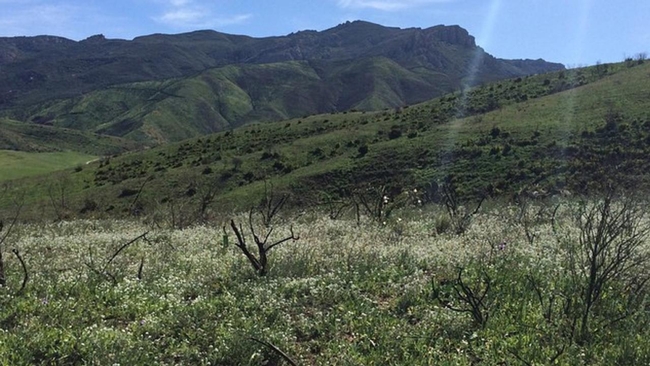
Posts Tagged: plant
Invasive Pest Spotlight: Pampasgrass & Jubatagrass
Pampasgrass (Cortaderia selloana) is a common ornamental landscape plant that...
Green Hall of Famer Oki retires after 29-year UC career
UCCE specialist's research prevents water pollution, reduces water use
When interviewed to become a University of California Cooperative Extension specialist in environmental horticulture, Lorence “Loren” Oki was asked what kind of research he wanted to conduct.
In response, he showed the hiring committee a photo of a residential gutter. “Water is a big concern, and I found very little research on runoff from homes,” said Oki, explaining that studying residential runoff is what “started his career” with UC Agriculture and Natural Resources back in 2002.
Although he remains active supporting growers and advising industry leaders, Oki retired from UC ANR in July 2023. Before joining ANR, Oki worked as a researcher for UC Davis' Department of Environmental Horticulture studying greenhouse irrigation in 1994, bringing his total time with the University of California to 29 years.
Oki, professor emeritus of Cooperative Extension at UC Davis, led many research projects that advanced the green industry which includes landscapes, nurseries and floriculture.
“Loren is the epitome of a specialist,” said Darren Haver, UC ANR's Research and Extension Center system director, who has worked with Oki for more than 20 years on projects that have significantly improved urban water quality and water conservation efforts across California.
Research influences pesticide management statewide
With a $3 million grant funding a statewide study, Oki and Haver set out to characterize runoff from residential sources over a five-year period. They determined the volume of irrigation runoff from residential land use, as well as the pollutants in the runoff.
Oki and Haver, co-principal investigators, along with researchers from UC Davis and UC Riverside, discovered that the degradation products of the insecticide fipronil – commonly found in runoff water – were more toxic than its parent compound. The study led to an investigation of human pathogens and pathogen indicators in residential runoff, the first of its kind.
Another contribution was the early detection of a new pesticide used for ant control, enabling strategies to be put in place to prevent it from reaching local streams and creeks. Oki and Haver's work also persuaded the California Department of Pesticide Regulation to change pesticide labels to minimize the chances of pesticides moving off target during irrigation and rain events.
These changes included preventing pesticide application before predicted rain and preventing irrigation after applications, keeping pesticides from impervious surfaces, and restricting applications on lawns and landscape beds within two feet of impervious surfaces and others.
Plant trials expand beyond California
Oki was also the principal investigator of the Climate-Ready Landscape Plants project, which may be the largest irrigation trial in the western U.S., and the UC Plant Landscape Irrigation Trials, the California component of that project. The UCPLIT trials originated in 2004 at UC Davis as a research project by Karrie Reid, retired UCCE environmental horticulture advisor for San Joaquin County, while she was pursuing her master's degree. In 2017, the irrigation trials were duplicated at the South Coast Research and Extension Center.
These projects evaluate landscape plants under varying irrigation levels to determine their optimal performance in regions requiring supplemental summer water. Throughout the trial, Oki identified many landscape plants, including rose cultivars, that remain aesthetically pleasing with little water.
Today, the trials have expanded beyond California as the Climate-Ready Landscape Plants Project at Oregon State University, University of Washington, University of Arizona and Utah State University.
Growing up in the nursery industry
In 2017, Oki obtained tenure, allowing him to expand his professional responsibilities to include production horticulture, specifically greenhouses and nurseries, an industry he was extremely familiar with. “I come from a nursery family,” Oki explained. “My grandfather started Oki Nursery in the early 1900s.”
During World War II, Oki's family was incarcerated in the Poston Relocation Center in Arizona and lost their homes and property. When they were released, they returned to the nursery industry to rebuild their lives. “After World War II, my father and uncle got more involved with my grandfather's work,” he said.
The Oki family played an instrumental role in technological development for nurseries in general. Oki Nursery, which was located in Sacramento, worked closely with IBM and was the first to use a computerized system in the industry.
Oki developed computerized scheduling for the bedding plants, poinsettias, chrysanthemums, bulbs and other crops. He developed a method to calculate the cost of any crop grown by the nursery at any point in the crop cycle and computerized greenhouse environmental and irrigation controls. This may not sound impressive now, but that was in the 1980s.
“My father was known for being progressive and he also knew everyone at UC Davis,” said Oki. “He wanted to work with anyone who had an interest in doing something good for nurseries.”
Inducted into Green Industry Hall of Fame
In the 1950s, Oki Nursery partnered with researchers from UC Davis' agricultural engineering program and developed the overhead sprinklers commonly used in nurseries today. Until the 1980s, Oki Nursery was the largest nursery in Northern California. Before it shut down in 1993, Oki worked in the family business as a greenhouse manager when runoff became a growing concern.
“I remember getting served with a notice by the Regional Water Quality Control Board stating that we needed to prevent runoff because it was polluted with nitrate fertilizer, which was common in the nursery industry,” Oki said.
One of those efforts focused on using controlled-release fertilizer instead of applying fertilizer via irrigation as a liquid feed. “What we learned is that if we converted nurseries to controlled-release fertilizer, we could reduce the nitrate runoff,” he said. While a member of the Oki Lab, Bruno Pitton earned his Ph.D. studying nursery hydrology and the fate of nitrogen fertilizers in container crop production adding to the information on runoff and nitrate management. Pitton is now the environmental horticulture advisor for Placer and Nevada counties.
In 2023, Oki was inducted into the Green Industry Hall of Fame, which recognizes individuals with a minimum of 20 years in the landscape, nursery or floriculture industry and who have made significant contributions to the field.
Having grown up in the industry, Oki said that his father taught him to never be afraid to try new things. “If you think you have an idea that might work, do the best you can to make it work. If it doesn't work out, then it doesn't work out. And that's OK,” he said.
Revitalizing space for greater impact
This mentality encouraged Oki whenever tackling new tasks, like rebranding the California Ornamental Research Federation, a space for education and collaboration, as UC Nursery and Floriculture Alliance.
In 2009, Oki and David Fujino, executive director of the California Center for Urban Horticulture, became co-directors of CORF, which catered to the cut flower industry. At that time, Oki and Fujino realized that nurseries generated much greater revenue in the state than cut flowers.
“It was a strategic decision to change CORF to UCNFA, which included floriculture and nurseries in the name,” Fujino said. Combined, nurseries and floriculture have consistently placed in the top five agricultural commodities in the state.
When reflecting on their partnership, Fujino said that working with Oki was a “natural fit.” “I couldn't have asked for a better partner, a better colleague and, ultimately, a better friend to have my back and work side by side,” he added.
Since UCNFA's launch, the two have worked to maintain the group's impact by hosting “Ask your Advisor” webinars to connect advisors to growers, as well as co-hosting large-scale events such as the annual conference for the International Plant Propagators' Society — an organization focused on greenhouse and nursery production education — for the Western Region, which Oki's father helped establish in the 1960s.
Encouraging a return to education
Gerry Spinelli, UC Cooperative Extension production horticulture advisor for San Diego County and member of UCNFA's administrative committee, described those who have learned from Oki as his sons and daughters. “When I meet someone that's learned from Loren or worked with him, that person instantly becomes my friend. That's the kind of effect Loren has on us,” Spinelli said.
Grant Johnson, UC Cooperative Extension urban agricultural technology advisor for Los Angeles and Orange counties, credits Oki for his master's degree in horticulture from UC Davis.
“Loren gave me a lot of direction as far as career choices and research interests. He instilled in me a dedication to life-long learning, just like he continues to do,” said Johnson. Before Oki became his professor, Johnson worked with Oki as a staff research associate at the South Coast Research and Extension Center in Irvine.
Another influential person in Oki's life is John Kabashima, emeritus environmental horticulture advisor for UCCE Orange and Los Angeles counties and fellow Green Hall of Fame inductee. Like Oki, Kabashima grew up in the nursery industry.
Oki, who earned a bachelor's degree in ornamental horticulture from Cal Poly San Luis Obispo and a master's degree in plant science from UC Riverside, decided to pursue a Ph.D. in ecology at UC Davis with Kabashima's encouragement.
While Oki was still working in his family's business, Kabashima said that Oki relied on UC ANR researchers for scientific information and felt like Oki wanted to be one of them. “I told him that he's a good nursery guy, but he's a better scientist,” said Kabashima. “His heart is in science.”
The two began working together as soon as Oki became a graduate student and have been colleagues and friends for nearly 40 years. “My favorite response from Loren whenever people ask him a question is, ‘It depends,'” Kabashima said. “It always leads to people opening up and giving more context. That's what Loren does, he gets you to think.”
Latest research in fire science focus of free webinar series
Wildfire, cultural and prescribed burns, plant flammability among topics covered
Interested in learning about some of the latest research in fire science and stewardship? Join the UC ANR Fire Network for a series of free lunchtime webinars to explore fire science topics with colleagues from across the globe.
This four-part webinar series will address fire in land management, plant flammability, fire history and management and forestry and fuel profiles.
Everyone is welcome to watch the Hot Topics in Fire Science and Stewardship Webinar Series.
Restoring Fire to Meadows and Other Cultural Landscapes
Presenters: Alice Lincoln-Cook, California Indian Basketweavers Association; Brian Peterson, Fire Forward
- May 29, noon–12:45 p.m. Pacific Time
- Register by May 29: https://bit.ly/3Qksc0J
How Can We Assess Plant Flammability?
Presenters: Jane Cawson, University of Melbourne; Max Moritz, UC Santa Barbara and UC ANR
- June 5, 3–3:45 p.m. Pacific Time
- Register by June 4: https://bit.ly/3WetrlA
Nuances in Fire History and Management: Lessons from Oregon Presenters: Andrew Merschel, U.S. Forest Service Pacific Northwest; Chris Dunn, Oregon State University
- June 12, noon–12:45 p.m. Pacific Time
- Register by June 11: https://bit.ly/44fMU7u
Forestry and Fuel Profiles
Presenters: Don Radcliffe, University of Washington; Eric Knapp, U.S. Forest Service Pacific Southwest
- July 17, noon–12:45 p.m. Pacific Time
- Register by July 16: https://bit.ly/4aTqI5Q
For more information, visit https://ucanr.edu/sites/fire/Home_430/Events.
Car fumes, weeds pose double-whammy for fire-loving native plants
Wildflower displays threatened
Northwest of Los Angeles, springtime brings native wildflowers to bloom in the Santa Monica Mountains. These beauties provide food for insects, maintain healthy soil and filter water seeping into the ground – in addition to offering breathtaking displays of color.
They're also good at surviving after wildfire, having adapted to it through millennia. But new research shows wildflowers that usually would burst back after a blaze and a good rain are losing out to the long-standing, double threat of city smog and nonnative weeds.
A recent study led by Justin Valliere, assistant professor in the UC Davis Department of Plant Sciences, found that native wildflowers and other plants that typically flourish following a fire were, instead, replaced by invasive plants on land that received the kind of nitrogen contained in vehicle emissions.
“Many native plants in fire-prone areas rely on fire, and some are entirely dependent on it. Some are even most abundant after a fire,” said Valliere, a UC Cooperative Extension specialist in invasive weed and restoration ecology. “But we found that these fire-following species may be especially vulnerable to the combination of nitrogen pollution and invasive plants.”
That's part of the reason why native plants in these mountains have been declining.
Seeds – banked in the soil and waiting to sprout
The problem faced by native plants can be compared to a drawn-down bank account: Funds withdrawn are not being replaced.
It starts with fire, an important ecological process, Valliere said. Flames burn through plants on the surface and return their nutrients to the soil. Seeds sleeping in the ground wait for the next rain to sprout, then use those nutrients to grow.
“Plant diversity is often highest in growing seasons immediately after a site burns,” he said.
But invading plants have many advantages over native ones. They often sprout earlier, grow faster and create more seeds, all while tolerating drought.
“They're like cheaters,” Valliere said. “They don't follow the same rules.”
Nitrogen, too, is an important piece of every plant's nutrition. They all get a fertilizing boost from nitrogen that floats up in vehicle emissions and falls to the ground. But the invaders use nitrogen and other nutrients to grow faster, winning the race for water and sunlight. As a result, fewer native plants reach maturity, producing fewer seeds that keep their populations thriving.
When the bank balance reaches zero
The 2013 Springs Fire gave Valliere a unique opportunity to study the combined impacts of wildfire and extra nitrogen. He and colleagues from UC Riverside and the National Park Service created test plots in the Santa Monica Mountains where the fire had burned. Then, they added nitrogen to the soil to mimic the amount and type that LA's smog would deposit. Over the study's three years, native plants that typically would have flourished after wildfire instead declined even faster in the plots with added nitrogen.
Native seeds sprouted, but didn't flower. Over time, the soil's bank of seeds drew down.
“Each seed has one chance to flower and reproduce,” Valliere said. “If a seed grows and gets outcompeted, that seed has lost its chance to replenish the seed bank.”
Without the chance to replenish their bank account, native plants will die out, and the whole ecosystem will be thrown out of balance.
“There is inherent value in biodiversity,” Valliere said. “These invasive weeds could prevent the re-establishment of native shrubs after fire, sometimes forever altering the plant community.”
The loss of native plants can have cascading effects on the larger environment, he added. Problems can include the loss of native bees that feed on the flowers, and mudslides when rain makes hillsides unstable.
This problem is likely to repeat in similar areas where biodiversity is highest after wildfires – including parts of the Mediterranean basin, southern Africa and Australia. The addition of city smog “could have serious consequences for the biodiversity of fire-prone ecosystems worldwide,” Valliere warned.
Read the paper, “Nitrogen deposition suppresses ephemeral post-fire plant diversity,” by Justin Valliere, Irina Irvine and Edith Allen.
This article was first published on the UC Davis Department of Plant Sciences website.
Damping-off of Seedlings
Springtime planting is almost here but don't rush to plant seeds until the soil has warmed up!...

